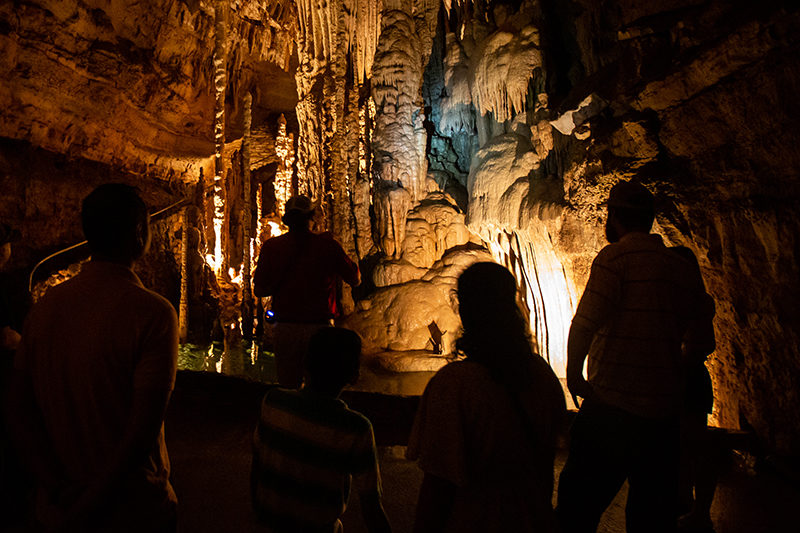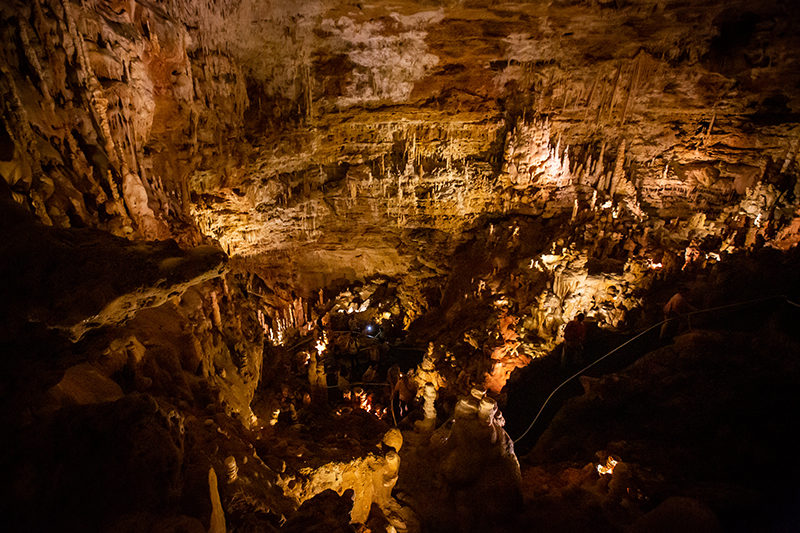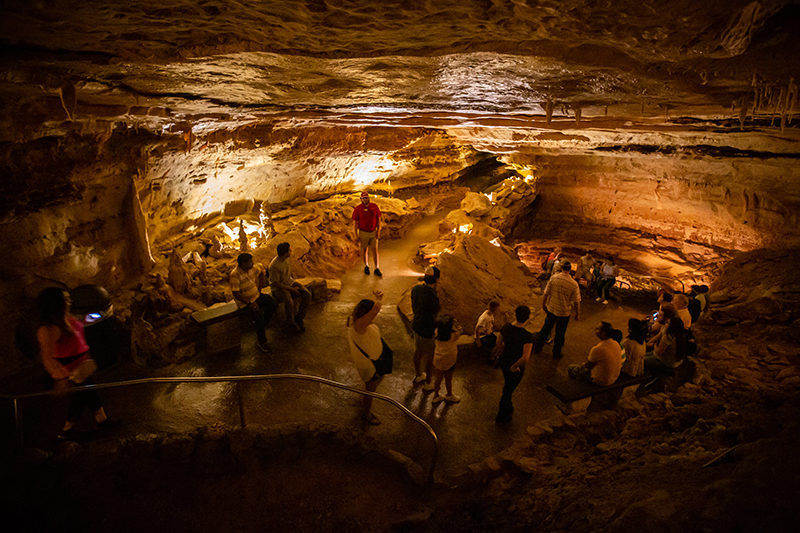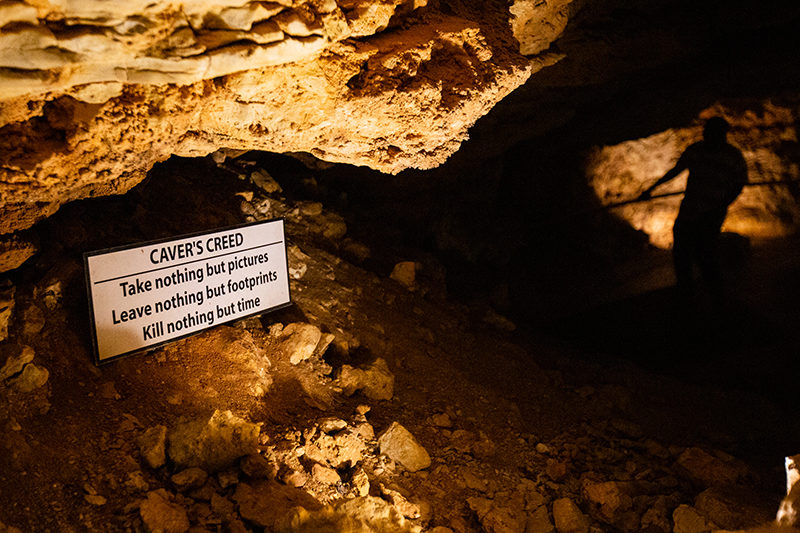Hill Country Caves Are Critical to Sustaining Above-Ground Life in Central Texas
By Michael Minasi
Reporting Texas

A tour guide highlights various rock formations while speaking with participants on Sunday, May 5, 2019, at Natural Bridge Caverns in San Antonio. Michael Minasi/Reporting Texas
A group of day trippers, mostly dating couples and families with children, joined a guided tour of the Natural Bridge Caverns near San Antonio on a recent Sunday for a taste of adventure in the depths of the Earth. Mouths not infrequently agape, they spent 75 minutes trekking through underground compartments featuring rocky spikes, limestone columns and other awe-inspiring structures formed over eons by the ebb and flow of subterranean waters.
As the group reached the deepest point in the cave system, 211 feet below the surface, they stopped at dark chasm ominously labeled “Purgatory Creek.” One man spurred a chorus of nervous laughter when he asked, “Anyone here seen ‘The Descent’?” The popular 2005 horror film follows a group of cavers ensnared in a fight for their lives with mysterious cave-dwelling creatures.
It may not be a case of life imitating art exactly, but in the eyes of environmental scientists, the survival of human communities above-ground in Central Texas may be deeply intertwined with what goes on in the caves below. Cave systems rapidly recharge underground water resources and reduce flooding. Their sensitive ecosystems act as monitors of environmental health above and below the surface. And they are highly vulnerable to the ravages of urban sprawl and agricultural and industrial pollution.
Nico Hauwert, who manages the Balcones Canyonland Preserve, said cities such as Austin have effective protection measures for protecting caves and enforce them — outlying areas, less so.
Before caves can be protected they have to be identified, however, and that’s often easier said than done. “There’s whole big tracts of land in cave areas where there are no caves identified,” Hauwert said.

The view from near the top of the Hall of the Mountain King, the largest section of Natural Bridge Caverns, is pictured on Sunday, May 5, 2019, in San Antonio. Michael Minasi/Reporting Texas
Many of them have been filled in over the past two centuries, mainly by primitive land management techniques — for example, farmers and ranchers looking to divert water to their mills or to protect their livestock from falling down shafts. Traditionally, caves were also used as dumping sites for trash.
Austin already enjoys a nationwide reputation for environmental activism, but even so, cave enthusiasts and those who tend caves, said public interest in preserving caves may be on the upswing. In 2018, voters in Austin approved a bond that set aside $72 million for the acquisition and protection of land that feeds the Edwards Aquifer, Barton Springs, and the Colorado River. In February, the Lady Bird Johnson Wildflower Center hosted its second annual Austin Cave Festival and was inundated with 3,000 attendees, more than double the previous year.
“I think it definitely shows that there’s an interest and people are curious,” said Tanya Zastrow, director of programs at the Lady Bird Johnson Wildflower. “They don’t get an opportunity to go into caves very often,”
The center features two natural caves onsite, the La Crosse Cave and the Wildflower Cave, where visitors learn how water flows from the surface into the Edwards Aquifer.
“Ours are not your commercial-type, touristy caves … [they’re] a little bit harder to get into,” said Zastrow. “There are no paved paths through them or anything like that. One of them you can’t even stand in. You have to crouch and crawl around in it. So it’s a very unique and different experience.”
A hundred million years ago most of Texas was at the bottom of a shallow Cretaceous-era sea, according to geologists. Fifteen to 20 million years ago, shifting of plates in the Earth’s crust created massive cracks that caused the sea to drain, capturing acidic waters underground that slowly etched caverns and reservoirs.

A tour gathers in a section of Natural Bridge Caverns named Pluto’s Anteroom on Sunday, May 5, 2019, outside of San Antonio. Michael Minasi/Reporting Texas
One of those natural wonders is the Edwards Aquifer, which today crosses beneath 11 Texas counties and supplies most of the water for San Antonio and surrounding communities. It also supplies some of Austin’s water. The Edwards Aquifer is considered one of the most porous and productive aquifers in the United States — in large part due to its vast network of limestone caves and sinkholes.
Since caves are typically isolated and sensitive environments, they are often home to equally isolated and sensitive species such as the endangered Barton Springs salamander. As such, caves can act as red flags for environmental hazards that might go unnoticed on the surface.
“Who cares if this cave’s cricket population decreases?” said San Antonio resident Bennet Lee, a long-time caver and member of numerous local caving organizations. “Well, there’s a reason the cricket population decreased … It may be that you’re drinking … pesticide running off of the golf course or something like that.”
Water can travel more than a mile a day in the limestone of the Edwards Aquifer, versus taking up to a year to go the same distance in sandstone aquifers.
“Since water does travel so quickly through our aquifer … it’s essentially what goes in comes out. So any pollution that people are putting on the land is also going to end up in the aquifer and in the springs,” said Jessica Gordon, coordinator at the City of Austin’s Watershed Protection Division conservation program.
Caves scattered around the Hill Country form some of most critical conduits for water entering the aquifer. “If you have a housing development roll in and plug up a cave or put a parking lot on top of a cave feature, it’s no longer feeding the aquifer,” Lee said. “The more that happens the more that we’re basically starving our aquifer.”

A sign reads: “Caver’s Creed Take nothing but pictures, leave nothing but footprints, kill nothing but time” on Sunday, May 5, 2019, at Natural Bridge Caverns in San Antonio. Michael Minasi/Reporting Texas
Between the 1950s and 1990s, volunteer cavers identified and excavated about 200 caves in the Austin area, but since then almost 20 percent have been filled in or paved over by developers who believed getting rid of caves made properties more marketable, Hauwert said.
A common path for people to get involved with caving and conservation is through “grottos”—local caving clubs affiliated with the National Speleological Society. For members, grottos combine the thrill of exploring caves with cleaning and maintaining cave paths and monitoring the life in caves through cricket counts.
“There’s a lot of natural fears associated with caves,” Hauwert said. “They are the gateway to hell for some people. But once people go into the caves and experience them they learn to turn their fear into excitement.”